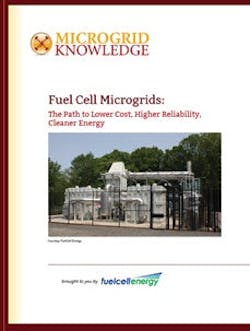A Fuel Cell Microgrid Keeps the Lights on for a Connecticut High School
This excerpt from “Fuel Cell Microgrids: The Path to Lower Cost, Higher Reliability Cleaner Energy” explains the multiple benefits a fuel cell microgrid brings to a Connecticut high school and the larger community.
Special Report: “Fuel Cell Microgrids: The Path to Lower Cost, Higher Reliability, Cleaner Energy“
Students at the Amity Regional High School in Woodbridge, Connecticut are in for a big letdown, but that’s a good thing.
While the school’s new 2.2 MW fuel cell microgrid will challenge them as a scientific learning lab, it will also mean an end to forced closures due to storm-related power outages. Like the post office (neither snow nor rain nor heat nor gloom of night), the microgrid will keep running when the main power grid fails due to inclement weather.
This provides multiple benefits not just to students’ education, but to the surrounding community as well.
“We view this project as a triple win including clean power for the community, reduced financial impact on the district, and educational opportunities for our students from this innovative fuel cell power generation,” said Charles Dumais, superintendent of the Amity Regional School District #5.
A good thing, too. This upscale woodsy community of nearly 9,000 residents is within a seagull’s wing of the ocean and gets all the wind, ice and fury of a Nor’easter, albeit buffered lightly by the Long Island Sound. Tropical Storm Irene and Superstorm Sandy unfortunately demonstrated the vulnerabilities millions of people suffer via power failures, flooding, sewer plant failures and water pollution.
During power outages, the fuel cell microgrid will island and serve seven critical buildings in this small town near New Haven. These include, in addition to the local high school, town hall, library, fire station, public works facility and senior center/emergency facility. The remainder of the time the fuel cell will supply the regional grid. And, in addition to supplying power, the fuel cell microgrid will also act as a heat source for the high school.
A utility microgrid, the project uses a new underground distribution circuit which separates from the remainder of the utility system to form the microgrid during islanding. The microgrid supports multiple facilities separated over a half mile expanse.
The fuel cell part of the microgrid project is complete and is providing power. The cell was provided by Connecticut-based FuelCell Energy. The company also is designing the microgrid controller that will run the project’s automated operation.
FuelCell Energy will operate the fuel cell under contract with local utility United Illuminating. The unit converts natural gas into electricity and heat through a highly efficient electrochemical process that requires no combustion, so creates no accompanying emissions.
The utility is using the project to help meet its state requirement to develop 10 MW of renewable energy. The fuel cell microgrid has received $3 million from the state’s microgrid grant program. A 2.8-MW fuel cell project in Bridgeport by United Illuminating, also powered by FuelCell Energy, will provide additional help to fulfill the utility’s commitment to provide cleaner energy.
See “Fuel Cell Microgrids: The Path to Lower Cost, Higher Reliability, Cleaner Energy,” downloadable at no cost, courtesy of FuelCell Energy.
About the Author
Elisa Wood
Editor-in-Chief
Elisa Wood is the editor and founder of EnergyChangemakers.com. She is co-founder and former editor of Microgrid Knowledge.
